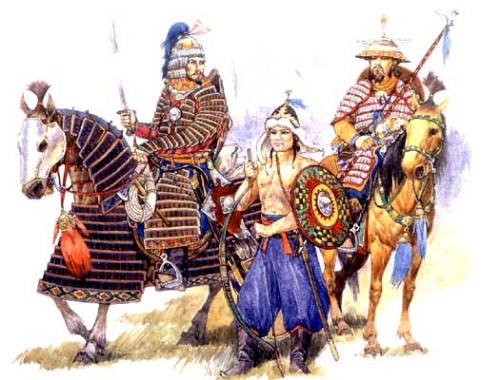The demand for falcons and furs from the “Peoples of the Forest” brought Mongol conquerors north to the Arctic.
The peoples of the Mongolian steppe had long maintained intimate relations with the peoples of the Siberian taiga (forest). They called those in the forest “People of the Forest” (Oi-yin Irged), but this term covered a wide range of peoples, many of whom were little different from the steppe Mongol people. The BARGA (Barghu), east of Lake Baikal, were like the Mongols except for keeping reindeer. Others, such as the “Forest” Uriyangkhai, lived in wigwams of birchbark, detested sheep, excelled in sledding, skiing, and reindeer herding, and tried to have as little as possible to do with the steppe Mongols. While the tribes around LAKE BAIKAL were Mongolic speaking, those to the west spoke Turkic, Samoyedic, or Kettic (Paleo-Siberian) languages.
In 1207 CHINGGIS KHAN (Genghis, 1206–27) sent his eldest son, JOCHI, to subjugate the forest tribes from the Barga east of the Baikal to the Bashkirs (Bashkort) near the Urals. He then organized the Siberians into three tümens, or 10,000 households. Chief Qutuqa Beki of the OIRATS, dwelling in the Shishigt valley, surrendered, and Chinggis made him a myriarch (commander of a tümen) and gave his daughter Checheyiken to Qutuqa’s son. The Yenisey Kyrgyz of Khakassia (ancestors of the modern Khakas and of uncertain relation to the Kyrgyz of modern Kyrgyzstan) also surrendered and were numbered as a tümen. Chinggis gave the Telengit and Tölös along the Irtysh River (ancestors of the modern Altay nationality) to an old companion, Qorchi, of the Baarin clan. Together with Qorchi’s original three Ba’arin 1,000s, this made Qorchi commander of a third Siberian tümen. Other peoples, such as the BARGA, Tumad, BURIATS, and Khori in the east, the Keshtimi in the center, and the Bashkirs to the west, were organized in separate 1,000s.
For tribute, gerfalcons and furs were the chief things the Mongols valued in Siberia, although Kyrgyz horses were also famous. Since gerfalcons nested only near the Arctic Ocean, the Mongols and their tributaries made regular expeditions all the way to the northern shores of Siberia. The Mongol khans did not regard this tribute as enough, however, and regularly demanded labor service and harem girls from the forest peoples. A Tumad rebellion broke out in 1217, when Chinggis Khan allowed Qorchi to seize 30 Tumad maidens. Dense forest and narrow mountain paths covered their territory along the Angara, and the Tumads captured Qutuqa Beki and killed Boroghul, one of Chinggis Khan’s “four steeds,” before Dörbei the Fierce of the Dörbed clan smashed them and freed Qutuqa Beki.
Despite the cold, Chinggis Khan settled a successful colony of Chinese craftsmen and farmers at Kem-Kemchik in the Tuvan basin. As the empire broke up in 1260, the Yenisey Kyrgyz and the colony at Kem-Kemchik became objects of contention between QUBILAI KHAN (1260–94) of the Mongol YUAN DYNASTY and his enemies. In 1262 ARIQ-BÖKE, cut off by Qubilai’s blockade, tried to use the colony at Kem-Kemchik as his base. After Ariq- Böke’s defeat Qubilai Khan sent a Chinese official, Liu Haoli, with a new batch of colonists to serve as judge of the Kyrgyz and Tuvan basin areas in 1270. From 1275 on, however, QAIDU KHAN, another rival, occupied central Siberia. In 1293 Qubilai’s Qipchaq general TUTUGH reoccupied the Kyrgyz lands, severing one of Qaidu’s important supply bases. From then on the Yuan controlled central Siberia.
Western Siberia came under the eastern, or BLUE HORDE, of the GOLDEN HORDE. Ruled by the descendants of Jochi’s eldest son, Hordu, this area was isolated and conservative. In the swamps of western Siberia, dogsled JAM (post) stations were set up to facilitate collection of tribute in sable, ermine, black fox, and other furs. With the breakup of the by-then Islamic and Turkish-speaking Golden Horde late in the 14th century, a Siberian khanate was formed with its center at Tyumen’ (from Mongol tümen, 10,000). The non-Chinggisid Taybughid dynasty (probably KEREYID in origin) vied for rule with the descendants of Shiban, Jochi’s fifth son, until Russian Cossacks drove out the last Shibanid khan, Kuchum, in 1582. Qorchi’s Baarin tümen, moving south to the Tianshan Mountains and assimilating nomads from the Blue Horde, formed the nucleus of the modern Kyrgyz of Kyrgzstan. Even today, the Kyrgyz’s dominant clan, the Taghai, is named after Qorchi’s son.
Further reading: Allen Frank, The Siberian Chronicles and the Taybughid Biys of Sibi’r (Bloomington, Indiana University, 1994).
